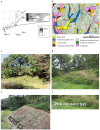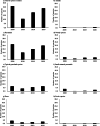Fast grassland recovery from viable propagules after reintroducing traditional mowing management on a steep slope
- PMID: 38854795
- PMCID: PMC11162179
- DOI: 10.7717/peerj.17487
Fast grassland recovery from viable propagules after reintroducing traditional mowing management on a steep slope
Abstract
Semi-natural grasslands on steep slopes often show high plant species diversity. These grasslands were traditionally maintained through mowing and/or grazing. The traditional management practices help to maintain species diversity, whereas land abandonment reduces diversity by increasing competition from dominant species and reducing seedling recruitment. The reintroduction of management can reverse species diversity declines, but suitable grassland restoration programs are scarce in Japan. To study the effect of short-term abandonment on seedling ecology, we monitored the vegetation of a Susogari grassland that had been abandoned for 3 years; the grassland occupies a steep slope (ca. 50°) on a hillside above paddy fields, and was traditionally mown. We monitored the vegetation before abandonment, in the 3rd year of abandonment, and in the 1st and 2nd years after restoration of mowing management. Emergence and survival of seedlings was monitored for 18 months after reintroduction of management. We monitored 1,183 seedlings of grassland species and non-target annuals in ten 1-m2 plots. After mowing was reintroduced, most grassland species reappeared or increased in the first and second years. Few seedlings of perennial plants and no seedlings of annuals flowered. An exotic species, Solidago altissima, had a lower survival rate (10%) than grassland species (>30%), and all but two grassland species survived over the 18-month period. Although vegetation composition was not fully recovered, our findings suggest that a steep slope acts as a strong filter that inhibits the establishment of non-target species while enhancing persistence of target grassland species.
Keywords: Seedling emergence; Seedling establishment; Semi-natural grassland; Survival rate; Susogari grassland.
©2024 Yamada et al.
Conflict of interest statement
The authors declare there are no competing interests.
Figures





References
-
- Bennie J, Hill MO, Baxter R, Huntley B. Influence of slope and aspect on long-term vegetation change in Britain chalk grasslands. Journal of Ecology. 2006;94:355–368. doi: 10.1111/j.1365-2745.2006.01104.x. - DOI
-
- Bricca A, Tardella FM, Tolu F, Goia I, Ferrara A, Catorci A. Disentangling the effects of disturbance from those of dominant tall grass features in driving the functional variation of restored grassland in a sub-Mediterranean context. Diversity. 2020;12:11.
-
- Chen D, Zhang B, Fadda C, Jarvis D, Bergamini N, Han G, Zhao M, Bai K, Zhang Z. Spontaneous grassland recovery on abandoned croplands in northern China: different vegetation patterns in desert and typical steppe. Science of the Total Environment. 2021;790:148155. doi: 10.1016/j.scitotenv.2021.148155. - DOI - PubMed
-
- Chibaken-shiryou-kenkyu zaidan . Chibaken-no-shizenshi (4) Chibaken-shokubutsushi [Natural source book of Chiba Prefecture (4) Flora of Chiba Prefecture] Chiba-Nippousha; Chiba: 2003. (in Japanese)
MeSH terms
LinkOut - more resources
Full Text Sources

